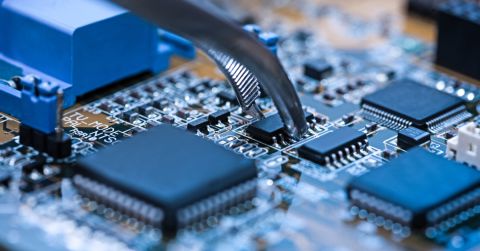Feedthrough and Common Mode Chokes Suppress High-Frequency EMI

Suppressor is the colloquial term for noise abatement devices within electrical circuits and is commonly known as filters. Along with PCB layout techniques, filters are used to attenuate noise. The noise is generated by switching circuits that either conduct transients through cabling or radiate magnetic flux into space. Noise is carried on both single-ended or differential pairs of transmission lines. There are filters suited to either type of these transmission lines.
Filters come in many shapes and sizes, suitable for almost any type of electrical signal. A filter is usually optimized for either differential or common-mode noise. Evaluating your circuit for possible noise injection via high-speed digital circuits or from high-power switching supplies is the first step towards selecting filters for your design’s required immunity or susceptibility requirements. The filters we discuss in this article address two suited to single-ended and one suited to differential pairs of transmission lines.
Defining Characteristics for High-Frequency Filters
Filters aim to eliminate or significantly reduce noise introduced into, or caused by, your circuit design. Your circuit is able to produce noise when impedance is available to build radio frequency voltage. The RF voltage is unintended and interferes with your circuit’s normal operating intent.
Reasons for noise generation are numerous but some include switching transients from your upstream circuits, mismatched impedances at connection points, and mismatched node and/or wire thicknesses connecting elements. In addition, noise may be acquired by your circuit from adjoining devices or from high-power radio frequency devices elsewhere in the environment. With carefully placed filters, you can protect your device from susceptible signals or from broadcasting internally-generated signals to the outside world.
- Attenuation: Reduction of energy.
- Cut-off Frequency: The boundary at which energy begins to attenuate.
- Impedance: The effective resistance of an electric circuit.
- Insertion Loss: The loss of signal from the insertion of a device.
- Poles: Values where the filter rolls off.
 Use a choke on differential pairs to attenuate common-mode noise
Use a choke on differential pairs to attenuate common-mode noise
Three High-Speed Filters for Consideration
Choosing a filter for your application involves predicting the signals in your design that will generate noise and determine frequency and timing of the response. For nodes operating at a low frequency, a filter providing cut-off of noise above a certain frequency will suffice. If the noise happens close to the cut-off frequency, you may want a faster roll-off accomplished with more elements.
Your aim is to shunt the noise to ground, keeping it away from your operating signals. In addition, at high frequency, your nodes become transmission lines. With transmission lines, inductive impedances show up and need to be considered when evaluating for attenuation. Reaching resonance with planned elements can interfere with the filter’s ability to attenuate noise. Inability to attenuate noise is insignificant at some frequencies. Knowing your requirements and frequencies of interest will help you analyze and choose the correct filter.
We look at three filter solutions below: a feedthrough capacitor, a three-terminal capacitor, and a common-mode choke.
 Feedthrough capacitor within capacitor types
Feedthrough capacitor within capacitor types
Feedthrough Capacitor Filter
A feedthrough capacitor is a shielded axial conductor with a capacitive shunt to ground. The ground connection is intended for solid attachment to the metal enclosure and/or bulkhead of the device. This makes the feedthrough capacitor suitable for high-speed signals operating in the UHF band or higher. As the outer conductor shields the signal’s lead, any emissions are directed to ground. As the ground tie is important for shunting, care must be taken to ensure the metal enclosure is free of high-impedance paint or coatings.
If your design has need for shielded filtering suitable for high-speed applications, take a look at the T-filter offered by TDK Corporation, the TDK-ACH4518-223-TD01.
TDK-ACH4518-223-TD01
This is a shielded T-filter providing 25dB attenuation in the frequency range of 9 to 65 MHz. It is suitable for power applications with a rated voltage maximum of 50V and a current maximum of 2.0A. Its DC resistance is 0.06Ω.
The ACH series consists of products with superior attenuation characteristics, in which the T-type filter circuit is magnetically shielded with ferrite. The series offers even greater attenuation characteristics when used in a stable circuit on the ground. The ACH series is ideal for high-density circuit design since the series is vertically mounted and does not require much mounting space. It is available for reflow soldering. It is a product conforming to RoHS directive.
The ACH4518 package dimensions, circuit diagram, and recommended PC board pattern are shown below:
 ACH4518 footprint, schematic, and landing pattern
ACH4518 footprint, schematic, and landing pattern
Three-Terminal Capacitor Filter
A three-terminal capacitor filter is composed of two shielded axial conductors in series, each capacitively shunted to ground, with ferrite material between and in series with the two shielded conductors. This configuration uses lead inductance to enhance filtering resulting in a sharp Q resonance and can extend the frequency range of operation making it useful in the VHF and higher bands. Care must be taken to bond the ground connections to chassis using low inductive bonding techniques to maintain the performance of the filter.
If your design would benefit from de-coupling for high-current power applications, take a look at the three-terminal capacitor offered by Murata, the NFM18CC101R1C3D.
Murata NFM18CC101R1C3D
This is a three-terminal capacitor designed for power applications where large current is present. Its nominal capacitance is 100 pF and may be used in circuits with rated voltages of up to 16V. It is a rated to 20% capacitive tolerance at currents of up to 500 mA(DC) with specified DC resistance of 0.3Ω maximum.
 Murata NFM18 three-terminal capacitor schematic
Murata NFM18 three-terminal capacitor schematic
Common-Mode Choke Filter
A common-mode choke filter is designed for use with differential-mode transmission lines to remove unwanted common-mode noise. This type of filter is commonly used on AC mains or high-speed communication signals. Common-mode noise typically occurs from mismatch in line lengths or from impedance discontinuities from the differential pair. As the common-mode noise is generated throughout the design affecting downstream devices, this filter is customarily placed at the load. By placing the choke at the output, noise is shunted to ground preventing delivery to system devices.
If your design has high-speed differential signals in need of common mode filtering, take a look at the common mode choke offered by On-Semiconductor, the EMI4193MTTAG.
On-Semiconductor EMI4193MTTAG
This is an IC containing three common mode chokes for use in mobile phones and digital still cameras. It is rated to maximum DC current of 100 mA per line. In addition, it provides protection from ESD to upstream circuit components.
The EMI4193 is an integrated common mode filter providing both ESD protection and EMI filtering for high-speed digital serial interfaces such as HDMI or MIPI D-PHY. The EMI4193 provides protection for two differential data line pairs in a small RoHS-compliant WDFN16 package. Its features include a highly integrated common mode filter (CMF) with ESD protection providing protection and EMI reduction for systems using high-speed serial data lines with cost and space savings over discrete solutions. It includes large differential mode bandwidth with cutoff frequency greater than 2 GHz for high common mode stopband attenuation. It also provides ESD protection to IEC61000-4-2 Level 4, +15kV contact discharge. It is characterized by low channel input capacitance providing superior impedance matching performance. It comes in a low profile package with a small footprint in a WDFN16 2x4mm lead-free package.
The EMI4193MTTAG electrical schematic is shown below:
 On-Semiconductor EMI4193 electrical schematic
On-Semiconductor EMI4193 electrical schematic
Determining the type of filtering for your circuit needs is an important task within circuit design. Consider your signals and if you are designing for high-speed in the VHF and above radio frequency bands, you may want to employ filter topologies that provide direct shunt to ground of your high-frequency noise. Employing direct ties to chassis eliminate opportunities for noise generation through unnecessary impedance. If you are searching for filters suitable for the upper-frequency bands, or any other filter needs, let Octopart help you find the right part.
Stay up-to-date with our latest articles by signing up for our newsletter.








